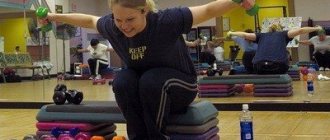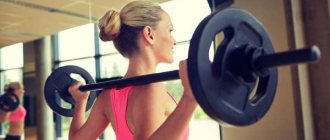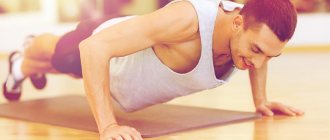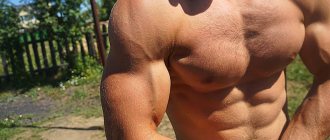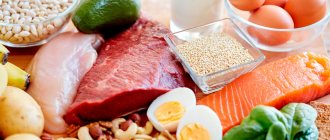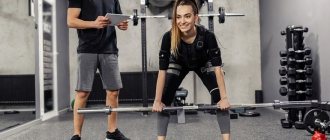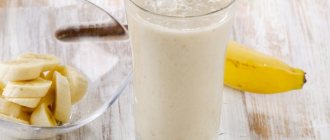Hi people. Once again (God willing, not the last) I welcome everyone to the pages of Fitkis Club.
Who doesn’t know yet, my name is Vitaly Okhrimenko and today we will chat about running and bodybuilding. But before moving on to the article, I would like to congratulate the miners of our planet on their professional holiday: MINER’S DAY !
Well, now let’s get on with the topic of today’s article!
My opinion about running and bodybuilding
Personally, I haven’t liked running since childhood. I don't even know why this is so. My parents claim that as a child I was a fairly active child, but I hated running around at school. As a matter of fact, I completely skipped physical education at school. Well, okay, that's not what we're talking about now.
When I started bodybuilding, I heard or read somewhere (I don’t remember now) that running interferes with gaining muscle mass. They say running burns muscles, it takes too much energy. I was completely satisfied with this option, since in those years I had not yet quit smoking, my respiratory organs completely agreed with me. But the years go by, the treasure trove of wisdom gradually increases, and today I have the opportunity to take a different look at the role of running in bodybuilding.
Once, after training all winter in the “mass” mode, I wanted to regain my six-pack abs by the summer and began to sometimes run before and after training. Lo and behold, besides the fact that my figure at that time acquired a more aesthetic appearance, I began to feel much better.
For a long time, I periodically included jogging in my training program, listening to the sensations and making observations. In short, by today I already have a perfectly formed point of view regarding running and bodybuilding. But of course this is not enough. So I had to study the issue inside and out in order to give you this article today.
Girls and boys are different...
And now we come to the most interesting part. Surely, every bodybuilder knows the distinctive characteristics of different body types. There are three human somatotypes:
- ectomorph;
- mesomorph;
- endomorph.
This is important for an athlete, because not only the formation of a training strategy and sports nutrition depends on the body type, but also the final result - the athlete’s figure itself. Therefore, running is not recommended for everyone, especially when a person is diligently building muscles.
An ectomorph refers to a lean body type that has a very difficult time developing muscle mass and even more difficulty maintaining it. High-intensity strength training and a minimal amount of cardio are recommended for him.
A mesomorph has a broad chest and shoulders, voluminous muscles and a minimal amount of body fat. He can be considered lucky, since he already has an athletic figure by nature. It is enough to exercise regularly, combined with running, every other day for 35-40 minutes, and a stately body is guaranteed for many years.
An endomorph has a round shape, a wide waist and bones, and a high percentage of subcutaneous fat. He is recommended to run for 40-45 minutes in order to activate metabolic processes and burn extra calories.
Most often this is interval running, accompanied by local accelerations, which is recommended after training. At this moment, subcutaneous fat becomes a source of energy and is effectively broken down.
Therefore, before you run along with the morning rays, decide what somatotype you belong to, weigh the pros and cons, and run for your health.
Is running good or bad for bodybuilding?
There are two fundamentally contradictory camps. Some are for running and bodybuilding, others are against. Today we will look at the fair arguments of both sides and try to draw conclusions for ourselves.
Running and bodybuilding, arguments against:
- running burns fat and increases sweating , thereby preventing muscle gain;
- running before training takes too much energy, and there is not enough left for the training itself;
- the benefits of running are clearly exaggerated and it does not actually burn as much fat as is commonly thought;
- intense running after a workout forces the body to spend resources first on restoring energy, and only then on filling the muscles with proteins;
- long running provokes catabolism processes in the body (muscles break down to restore energy levels);
- in combination with heavy squats, running increases the risk of injuring the knee joints;
Running and bodybuilding, arguments for:
- while running, the cardiovascular system receives a prolonged moderate load, which has a positive effect on its health;
- running increases endurance , which is very useful for athletes;
- weight gain requires increased blood flow in the body, subject to increased load;
- Running itself does not play a huge role in gaining muscle mass, however, thanks to the systematic strengthening of the heart muscle, running has an auxiliary effect for bodybuilding ;
- running perfectly tones the muscular system, in this state the muscles are better amenable to training;
- increased sweating during running removes toxins from the body ;
- According to research results, people who regularly run have an improvement in their metabolism;
- while running, small muscle fibers are worked out , which generally has a positive effect on the effectiveness of weight training;
- running before training perfectly warms up the muscles , preparing the entire muscular system for intense training;
- running improves the respiratory system , which in turn has a positive effect on filling the muscles with much-needed oxygen;
- running after training increases the filling of cells with oxygen;
- moderate, stable running improves the athlete’s recovery capabilities;
- running improves the sexual performance of a bodybuilder, and sex and bodybuilding are known to be good friends;
- during a quick run over short distances (sprinting), fast muscle fibers are perfectly activated, which increases the anabolic effect (muscle growth);
- while running, all the muscles of our body work, and the development of all muscles is one of the basic tasks of bodybuilding;
Tests while playing sports
Any type of regular physical activity or exercise in the gym has a beneficial effect on a person’s respiratory, cardiovascular, musculoskeletal systems, metabolism, mood and sleep.
Their goal is to strengthen human health, extend longevity and improve the quality of life. But going to the gym is a responsible process. It must be remembered that the nature and volume of loads are individual and depend on many factors, for example, age, gender and initial health status.
Unfortunately, most beginning amateur athletes do not know that there is a “correct entrance” to the training process, and it begins with preparatory work, that is, before starting classes, it is necessary to undergo a comprehensive examination, which will allow one to assess the initial state of a person’s health.
This stage is mandatory, since, for example, the increased load that accompanies regular exercise can reveal previously unnoticed health problems.
This comprehensive study will help analyze the body’s readiness for a serious sports test, and structure the training process in the correct way so that it is as effective as possible for the athlete and does not cause negative reactions from the body.
Blood test
- the most important and mandatory comprehensive analysis, since blood is one of the most important objects of biochemical research, which gives an idea of all metabolic processes, changes in tissue fluids and lymph of the human body.
For amateur athletes, this study will provide an assessment of the current state of the body, as well as assess the potential for increased results. For a professional, this study is mandatory before a marathon, triathlon or other event associated with extreme physical activity.
A comprehensive blood test is also important in situations where an athlete is faced with dissatisfaction with his training process: for example, there are situations when an athlete trains hard, but his body is not ready to accept such a load, there is no positive dynamics or even a decrease in results. This can lead to constant fatigue and depression. Timely diagnosis of overtraining helps to restructure the training process in time and enjoy sports, as well as increase their effectiveness.
So, when should you get tested?
The first time is before you start visiting the gym. Subsequently - after 1-1.5 months of continuous training. The analysis is carried out in the morning, on an empty stomach (do not consume anything other than plain water for at least 60 minutes)
What do the indicators say?
So, for example, a general blood test (CBC) will tell you what problems an athlete has, even if he himself is not aware of them.
Hemoglobin
- a protein responsible for transporting oxygen in the body. Its increase indicates dehydration, blood thickening, excessive physical activity, and smoking. A decrease indicates signs of anemia (for example, legs and arms go numb in the morning), with chronic fatigue and decreased performance.
Red blood cells
- oxygen carriers. With regular exercise or sports, the number of red blood cells increases, resulting in an increase in the body's resistance to colds and infectious diseases.
By comparing the level of leukocytes before the start of training, as well as determining the nature of the change in the indicator (increase or decrease) during the training process, you can determine the level of adaptation to physical activity. And adjust the intensity of the load with maximum benefit. Also important are the cells of the immune system: leukocytes, lymphocytes and monocytes. You cannot miss the inflammatory process or its first signs, for example with a common cold. If there are deviations, then fitness classes must be suspended. A change in the number of immune system cells indicates inflammation in the body and continued exercise can “spread” the infection throughout the body, which will only cause more harm.
Leukocyte formula
- this type of study allows you to identify the presence of hidden infections, autoimmune diseases, which may be a contraindication for starting physical training, or limit the intensity and frequency of exercise. It also helps to determine the level of the body’s protective properties, which allows you to choose the most effective type and intensity of training.
ESR
- erythrocyte sedimentation rate. Determining this indicator is important before you start training. Since the acceleration of this indicator may be associated with the presence of infectious, inflammatory, autoimmune or oncological diseases. What you need to know to avoid harm.
Blood chemistry
– more in-depth analysis. This analysis allows us to determine:
- disturbances in water-salt metabolism;
- imbalance of microelements;
- inflammatory processes present;
- presence of infections;
- condition of internal organs;
- diseases of the endocrine system.
For example, determining cholesterol levels allows you to assess the risk of cardiovascular complications and determine the intensity of physical activity. Regular moderate exercise can achieve greater cholesterol reduction than occasional vigorous exercise.
It is worth noting that too intense physical activity with high cholesterol will not benefit the patient, but, on the contrary, will have an extremely negative impact on his well-being.
Creatinine
- a substance released when proteins are broken down in muscles. Low creatinine levels indicate that muscle mass is reduced.
Creatinine levels often increase during intense exercise or when eating a high protein diet. In this case, you should continue to play sports, but choose types of exercise with low intensity. Therefore, knowing the level of creatinine in the blood, physical exercise can normalize the indicator.
It is also necessary to determine the hormonal background of the body before starting active training.
This analysis allows us to determine:
- hormonal imbalance;
- metabolic disorders;
- disturbances in the functioning of the endocrine glands;
- problems with the thyroid gland;
- reasons for loss of strength
- reasons for sudden weight loss or gain.
Thyroid hormones (TSH)-
its increase in the blood causes weight gain. Moreover, this happens mainly due to water retention in the body. It also affects heart rate, so it is imperative to assess its level before starting training. In addition, the hormone level needs to be known not only for beginner athletes, but also for actively and long-term trainees. Excessively intense physical activity can cause TSH deficiency, which in turn leads to various metabolic disorders. And this also negatively affects physical performance and health levels.
Testosterone (husband)-
an important hormone that has a wide-ranging effect on a man’s quality of life. A high level of testosterone for the male body is good, a low level is bad.
Therefore, knowing your initial level of the hormone, its connection with the duration and intensity of training, the dependence of the level on half of the day, you can create an individual training plan to achieve the desired effect and receive recommendations for increasing the level of testosterone in the body (if necessary).
Testosterone (women)
- one of the hormones responsible for weight in women. Testosterone helps burn fat and strengthens bones and muscles. Low testosterone levels in women cause muscle loss and obesity.
Estradiol (m)-
This is a female sex hormone, which is the direct opposite of the male hormone testosterone. It is produced by the male body, but in small quantities. An increase or decrease in this hormone in a man’s blood leads to serious consequences. One of the main reasons for increased estradiol in men is excess adipose tissue. Knowing this fact, the problem can be solved quite simply: just go in for sports. In this regard, a man must control his hormonal levels.
Estradiol (w)-
Both high and low levels of the hormone can lead to weight gain. Also, knowing the level of the hormone allows you to wisely choose the type and intensity of training (if the level is low, you need to approach strength activities with caution, as this leads to increased production of testosterone - an estrogen antagonist - which will reduce the amount of the hormone even more). Excessively intense training can lead to a sharp decrease in the amount of fat tissue, which will cause hormonal imbalance and metabolic disorders.
FSH/LH
- determine the level of these hormones in case of excess body weight, since low levels of FSH and LH can lead to fat accumulation.
An ordinary gym goer does not necessarily need to thoroughly understand all the tests; he just needs to take them and consult a doctor with the results, who will give his opinion. And in the event of any complaints, deterioration of well-being during training, or significant changes in biochemical parameters, this must be done without fail.
Running and weight
The effect of running on muscle gain is also a rather controversial issue. On the one hand, running is not a very good friend for muscle mass because it burns a lot of calories and seems to interfere with gaining muscle mass. But on the other hand, running for weight gain is quite useful, because as a result of not too long, but intense runs, the anabolic effect in the body improves, which helps to distill ingested protein into pure muscle mass. In addition, calories are converted into energy during running, and not into fat deposits.
I can safely conclude that running and muscle mass are allies, as long as you don’t go too far with running. Running too often and for too long is not the best for muscle mass. Muscle fibers are destroyed, and the protein taken, instead of being deposited in the muscles, is partially spent to replenish energy costs.
It turns out that in order to maximize the positive effect of running on muscle gain, you need to reduce your running time and increase the amount of carbohydrates and proteins consumed. And vice versa - to give your muscles definition, you need to increase your jogging time, increase the amount of protein consumed, but reduce the amount of carbohydrates and fats you take. But in general, I can conclude that bodybuilding and sprinting are better suited to each other than bodybuilding and long-distance running.
How to burn fat quickly
The modern lifestyle, which includes poor nutrition and reduced physical activity, provokes the accumulation of excess weight in the body, and with it a bouquet of various diseases. Therefore, people need to know how to quickly burn fat and get rid of extra pounds in the shortest possible time without harming their health.
In addition, many are probably familiar with the situation when relatives or friends invite you to their wedding, and you realize that your favorite formal suit is several sizes too small because you have gained excess weight. Therefore, you need to lose 5-6 kilograms (or even more), and as quickly as possible. So how do you do this? You will find out the answer in this article.
How to burn fat correctly
To begin with, it is worth making a reservation that nutrition experts do not advise often resorting to methods of rapid fat burning, since this mainly loses muscle tissue and water contained in the body.
We gain weight slowly (usually it takes years), so we need to lose it just as slowly, since with this approach we get rid of fat.
But if you urgently need to lose weight, then you will most likely start looking for suitable diets that will help you achieve the desired results in a short time. But let's take a closer look at this point.
We all know that diets don't really work.
The human body notices a lack of nutrients and triggers a survival mechanism that has remained with us since the times of our distant ancestors, who often faced hunger.
Eating too few calories causes your metabolic rate to decrease, which reduces your body's ability to burn fat. At the same time, your body is increasingly sending hunger signals, causing you to crave foods filled with fat and sugar (i.e., high-energy foods) that you should avoid if you want to lose weight.
Research shows that repeat dieting actually makes it harder to lose weight and more likely to gain it because after you stop dieting, you return to your normal eating pattern, but you still have a reduced metabolic rate, causing your normal eating pattern to drop. leads to excess calories.
That is, you not only regain the weight you lost, but you can also gain a few extra pounds of fat.
Attention!
Considering this, in ordinary life, knowledgeable people will not go through exhausting diets, making an exception only for special cases. And before you start toning yourself up, you need to increase your metabolic rate so that after the diet you don’t gain excess weight again.
To do this, it is recommended to start strength training, which is known to have a positive effect on metabolic rate. The more muscle you have, the faster you can burn body fat.
Running and bodybuilding - compatibility
So, it is clear that running and bodybuilding are compatible . But for better compatibility you need to follow a number of recommendations:
- on days free from training, jog for no more than 30 minutes at a slow pace;
- before training, 5-10 minutes of jogging at a moderate pace is enough to tone and warm up muscle tissue;
- To get the maximum effect on prolonging the performance of the heart muscle, you need to run with the correct pulse and count it using a heart rate monitor . I gave the formula by which the correct heart rate for cardio is calculated here;
- 5-15 minutes of jogging a day is enough to grow muscle mass;
- In order to dry out the muscles as much as possible and give them definition, you need to run for 20–30 minutes after training , counting your pulse on the heart rate monitor (according to the formula).
The body can adapt to stress
It often happens like this: you start running, the numbers on the scale tend to smaller units. You like it and continue training, but after a couple of weeks you notice that the arrow has stopped. The weight has frozen, you are at a loss. And the question of how to run to lose weight arises again.
The reason is that our body can adapt to any load and adaptation occurs quite quickly if you do not change the intensity, duration of training, or lifestyle. After a couple of weeks, the usual 30-minute run stops working.
pixabay.com/
Bodybuilding and running before and after training
Should you run before and after training? Of course it is necessary, because this is the best cardio you can think of (although no, sex is better). We are not necessarily talking about running, we are talking about doing any kind of cardio before and after training.
Before training, running perfectly tones all muscle fibers. And after training, doing cardio with proper consideration of the rhythm of the heartbeat is most effective because all glycogen is removed from the liver during the workout, and there is simply no left for cardio after a hard workout. Thus, it is subcutaneous fat that is converted into the energy expended on running after an intense workout with weights.
Diet helps you build muscle and lose weight
Your daily diet is no less important when it comes to losing weight. To effectively fight adipose tissue, it is necessary to exclude high-calorie carbohydrate foods from the menu: sweets, baked goods, desserts, fast food.
Choose protein foods:
- fish;
- lean meat;
- cottage cheese and dairy products;
- seafood;
- eggs;
- legumes
Protein supports muscle growth, as it serves as the main building material of muscle tissue, plus protein foods are filling, and the body spends the most time digesting them. At this time, the feeling of hunger does not bother you.
Add sources of healthy fats to your diet: fatty fish, olive oil, nuts. Don't forget about the right carbohydrates: fruits, vegetables, whole grains. Such a balanced diet will provide you with energy for intense workouts, help build muscle and get rid of excess weight.
Bodybuilding running in the morning
I put my hand on my heart: I hate running in the morning. I tried it several times, this summer my wife and I went jogging 5 times in the morning while I was on vacation... my soul just doesn’t rest and that’s all. I know that running in the morning and bodybuilding go well together. More precisely, not to each other, I think when asked whether bodybuilding and running are compatible, it is correct to say that bodybuilding rather benefits from this.
Although, again, the combination of running and bodybuilding is not bad for running, because a bodybuilder is, first of all, a sports person with well-developed muscle tissue. But you don’t need to go overboard with running in the morning. 5-10 minutes of running at a moderate pace in the morning, and not even necessarily every day, will go well with iron sports. But if you run on an empty stomach for half an hour at a fast pace, then gaining muscle mass will be problematic.
On the scales: gym or running
What is the most important thing in sports? Of course, have a healthy body and... a trained heart. Because the endurance and functionality of the human body depends on the work of the heart muscle. But what is better to prefer for its development and strengthening: running or iron training?
In bodybuilding, athletes must pay special attention to the work of their heart. The greater the body weight, the more blood it needs, and the more voluminous the heart muscle itself should become.
To do this, you need to perform regular cardio training while maintaining a constant average heart rate of 110-140 beats per minute. It can be:
- fast walk;
- slow steady running;
- swimming;
- boxing classes;
- iron training, etc.
No matter what you do, the main thing is to set a moderate pace and maintain a heart rate of 110-140 beats per minute for 15-60 minutes. This means that by training your body muscles in the gym or running in the stadium, you simultaneously develop the heart muscle, making it easier to work further.
But at this time the knee joints may suffer when choosing any sports activity. This is due to the lack of warm-up before training, incorrect exercise technique, inappropriate shoes, fitness clothing, and even the wrong running surface.
They create pain in the joints and make them vulnerable to injury, and subsequently lead to the development of pathology of the musculoskeletal system. Therefore, while paying attention to the heart, do not forget about other parts of your body, creating comfortable and safe conditions for sports and maintaining human health during exercise.
Conclusions:
I hope the conclusions are drawn correctly, you shouldn’t choose running or bodybuilding, these things are perfectly compatible. If you approach running correctly, you can get great benefits from it for bodybuilding. Accordingly, running and bodybuilding are more friends than enemies. When working on mass, you need to reduce your running time, while working on weight loss, endurance and relief, you need to increase it. To minimize the harmful costs for a bodybuilder from running, you need to consume more proteins and fast carbohydrates.
So, personally, I am for running and bodybuilding ! It is quite possible that someone is against it. In any case, I ask each of you to leave your opinion in the comments under this post. Let me take my leave.
Health to everyone and good luck. Meet me on the pages of Fitkis.
Sincerely, Vitaly Okhrimenko .
